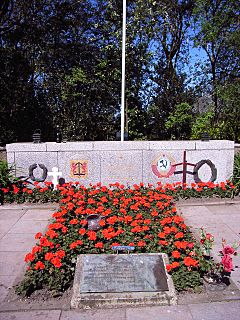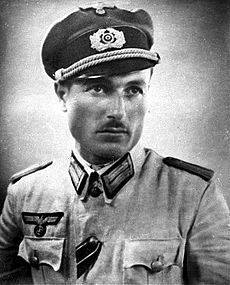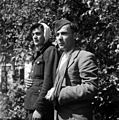Georgian uprising on Texel facts for kids
Quick facts for kids Uprising on Texel |
|||||||
|---|---|---|---|---|---|---|---|
| Part of the Western Front of 1944-45 in the European theatre of World War II | |||||||
 Georgian military cemetery on Texel |
|||||||
|
|||||||
| Belligerents | |||||||
|
|
|||||||
| Commanders and leaders | |||||||
| Casualties and losses | |||||||
| 565+ Georgians killed 120 Texel Dutch killed |
812+ Germans killed | ||||||
The Georgian uprising on Texel (Dutch: Opstand der Georgiërs) was a rebellion by Georgian soldiers on the Dutch island of Texel during World War II. It happened between April 5 and May 20, 1945. This event was one of the very last battles fought in Europe during the war.
The uprising involved the 882nd Infantry Battalion, called Königin Tamara (Queen Tamar). This battalion was part of the German Army and was stationed on Texel, which was occupied by Germany at the time. The battalion had about 800 Georgian soldiers and 400 German soldiers, mostly with German officers in charge.
Contents
Why the Uprising Happened
The island of Texel was a heavily fortified part of Germany's Atlantic Wall defense system. This was a long line of defenses built along the coast of Western Europe. However, after the Allied landings in Normandy in 1944, Texel became less important in the war.
The Georgian soldiers in the battalion were originally from the Georgian Soviet Socialist Republic. They had been soldiers in the Red Army (the Soviet army) and were captured by the Germans on the Eastern Front. These captured soldiers were given a difficult choice: either stay in harsh prisoner of war camps, where conditions were very bad, or join the German military. The men who chose to join the German army formed units like this one. Some people who had left Georgia because they were against communism also joined these units.
The 882nd battalion was created in Poland in June 1943. At first, they fought against partisans, who were groups fighting against the German occupation. In August 1943, the battalion was moved to the Netherlands. From September 1943 to early 1945, they were stationed in Zandvoort. Then, in February 1945, they were sent to Texel.
In late March 1945, the Germans began preparing to move some of the Georgian soldiers from Texel to the Dutch mainland. This was to help fight against the advancing Allied forces. This plan sparked the rebellion.
The Rebellion Begins
Just after midnight on April 5–6, 1945, the Georgian soldiers started their uprising. They quickly took control of almost the entire island. About 200 German soldiers were killed during this initial attack, either in their sleeping areas or while on guard duty. Members of the Dutch resistance helped the Georgians.
The Georgians hoped that the Allies would land on the island soon after their rebellion started, but this did not happen. Also, the Georgians failed to capture the German naval batteries (large guns) on the southern and northern coasts of the island. The soldiers operating these guns were the only Germans still alive on Texel.
The Germans ordered a counterattack. The remaining artillery batteries on the island began firing at places where they thought the rebels were hiding. About 2,000 German riflemen were sent from the Dutch mainland to Texel. Over the next five weeks, these German troops fought to take back the island. The fighting was especially fierce in the northern part of the island, near Eierland and the lighthouse.
After retaking the island, the German troops searched for any Georgian soldiers who were still hiding. Many Dutch islanders tried to hide the Georgians. The German commander of the 882nd battalion, Major Klaus Breitner, later called the uprising "treachery." Captured Georgian rebels were forced to dig their own graves and were then executed.
During the uprising, 565 Georgians, at least 812 Germans, and 120 Texel residents were killed. The island suffered a lot of damage, with many farms burned down. The fighting continued even after Germany officially surrendered in the Netherlands on May 5, 1945, and after Germany's general surrender on May 8, 1945. The battles finally stopped when Canadian troops arrived on May 20, 1945. They enforced the German surrender and disarmed the remaining German soldiers.
After the Fighting Ended
The Georgian soldiers who died are buried in a special cemetery at Hogeberg, near Oudeschild. The Georgians who survived the uprising feared what would happen to them. Under the terms of the Yalta Conference, many Soviet soldiers who had fought for the Germans were sent back to the Soviet Union. This often led to imprisonment, banishment, or even execution for officers.
The 228 Georgian soldiers who survived by hiding from the Germans (some in coastal minefields, others hidden by Texel farmers) were handed over to Soviet authorities. After arriving at a camp in the Soviet Union, 26 Georgians were banished with their families, and others were sent to labor camps called Gulag. Those who were still alive in the mid-1950s were allowed to return home.
Until 1991, the Soviet Union's ambassador to the Netherlands visited the Georgian graves on Texel every year. During later visits, the ambassador called the Georgians "Heroes of the Soviet Union." The Soviet Union also donated several memorials on Texel, including a pillar and sculptures at the Georgian cemetery.
Over time, fewer local people attended these memorial events. This was partly because the Dutch Communist Party, which had helped keep the memory of the rebellion alive, became smaller and eventually disappeared.
In the late 1960s, a movie called Crucified Island was made about the Texel rebels. It showed the rebels as prisoners of war who managed to steal weapons from the Germans.
On May 4, 2005, Mikheil Saakashvili, the president of independent Georgia, visited the graves for the first time. His visit was described as private, and he was with his Dutch-born wife.
The German soldiers who died were first buried in the general cemetery in Den Burg. In 1949, their bodies were moved to their final resting place at Ysselsteyn German war cemetery in the Limburg province of the Netherlands. This cemetery is managed by the German War Graves Commission. The Den Burg General Cemetery also has a section with 167 burials from World War II, mostly airmen.
There is a permanent exhibition about these events at the Aeronautical Museum at Texel International Airport.
One of the last Georgian survivors of the uprising died in July 2007 and was buried with military honors in Zugdidi, Georgia. In 2010, two Georgian survivors were still alive: Grisha Baindurashvili and Eugeny Artemidze. Artemidze, one of the main organizers of the rebellion, died at age 90 on June 22, 2010. Baindurashvili was still alive in 2015 and passed away at age 102 on August 6, 2021.
Counting the Casualties
Canadian troops, led by Lt. Col. Kirk, landed on Texel without fighting on May 17, 1945. This effectively freed the island. Over two days, the Canadians disarmed 1,535 German soldiers. Soviet forces called SMERSH arrived on Texel and took charge of the 228 Georgians who were still alive. A Canadian report for the SMERSH commander stated that 470 Georgians and 2,347 Germans were casualties on Texel.
In 1949, the German War Graves Commission dug up 812 bodies on Texel for reburial at Ysselsteyn German war cemetery. This number included over 400 Germans killed by the Georgians in their shared living quarters. The Texel district records list "565 Georgians, 120 Texel islanders and approximately 800 Germans killed." Other sources mention "more than 2,000 Germans killed." This higher number likely includes the 1,535 disarmed Germans along with the 812 dead, all grouped under "casualties" in the Canadian report to SMERSH.
Images for kids
See also
 In Spanish: Revuelta georgiana de Texel para niños
In Spanish: Revuelta georgiana de Texel para niños






